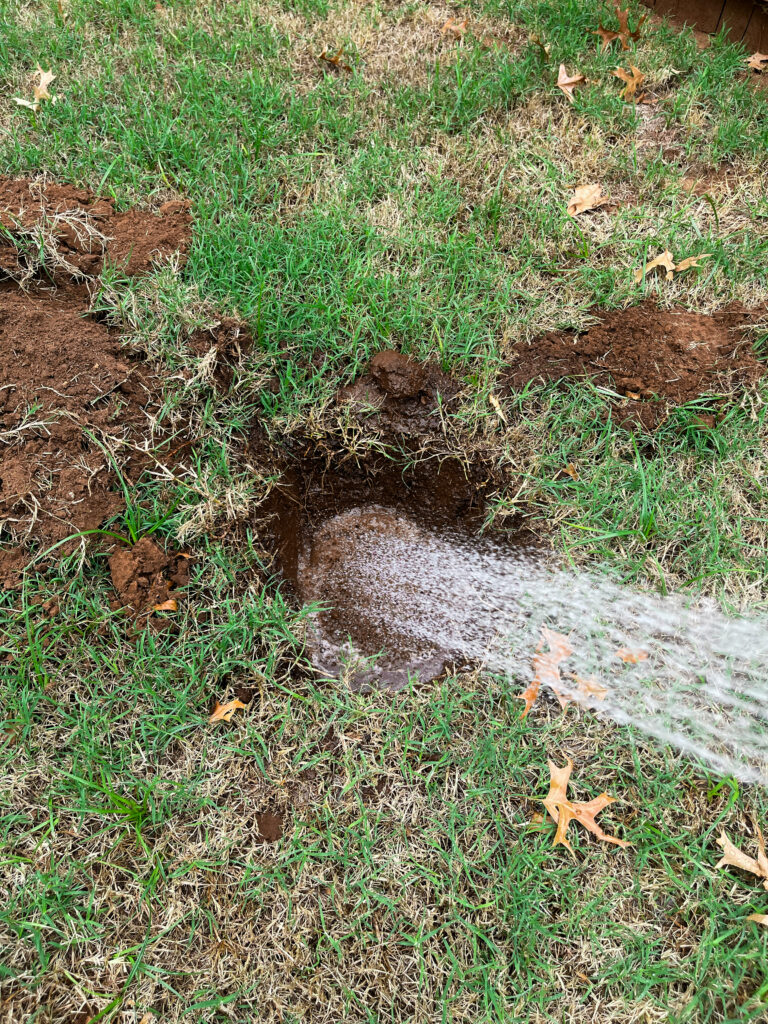EEEEEkk!!! It’s finally cooling off here in Oklahoma, and I am beyond ready for it. One of my favorite things about this part of the country is getting to experience all four seasons. By the end of each one, I’m ready for the next. Fall is officially here, so it’s time to collect seeds that are ready, cut back some plants, and move others that need relocated. We also have a GINORMOUS oak tree so planted fescue as well. Am I the only one that loves seeing all the baby grass poking up their delicate blades?

Today’s chore is to transplant an Aronia berry bush that is in my chicken yard. They have been terrorizing it by digging holes around the base and eating all the berries. It is also WAY too close to my blackberry bush so needed to be moved anyway. Wanted to share some tips specifically on transplanting plants as I move this one.

For some types of plants and in some places, planting in the fall can be a wise and effective gardening technique. When transplanting plants in the fall, keep the following points in mind:
Pick the Right Plants: Perennials, shrubs, trees, and some cool-season veggies and flowers are good candidates for transplanting in the fall. Our daisies are always ready to transplant to new beds from all the growth they have achieved in spring and summer months. The Warm-season plants shouldn’t be transplanted if they can’t handle the cold since they might not get established before winter.
Timing: Plants can establish their root systems before winter sets in by transplanting in the early fall, especially 4-6 weeks before the first anticipated frost. Don’t transplant plants too late in the season because the cold temperatures could prevent root growth. Don’t waste all the hard work you’ve put into your beautiful place!
Preparing the ground: To increase drainage and fertility, prepare the planting hole or bed by enriching the soil with compost or organic waste. You can make sure the pH of the soil is appropriate for the particular plant you are transplanting, but personally I’m a lazy gardener and usually just “wing it” planting willy nilly. 🙂
Watering: Before transplanting, keep the soil continuously moist but not soggy. This will also help if you water the place your plant will be transplanted. I know here in Oklahoma, the ground is too hard to dig if we haven’t had enough rain. To aid in their adjustment and lessen transplant shock, water the plants thoroughly right away after transplanting well.
Transplanting:
Create a hole that is somewhat deeper and larger than the root ball of the plant. Keep as much of the plant’s root system intact when you carefully remove it from its current place. Make sure the plant is positioned in the hole at the same depth as it was in its prior place.
To remove air, gently backfill the hole with earth and tamp it down. Watering will also help remove air pockets.

Mulch: To maintain moisture and protect the roots from temperature changes, spread a layer of mulch around the recently transplanted plant. Personally I use our used chicken wood chip bedding that has been sitting all year. This also helps with recycling so win win!
Frost protection: Be ready to cover newly transplanted plants in case of early frost or sharp temperature dips. Overnight, you can cover them with blankets, clothes, or frost cloths.
Trimming: When transplanting shrubs or trees, prune back any broken or overgrown branches, but avoid excessive trimming in the fall.
Watch and Water: Throughout the fall, keep an eye on the soil’s moisture content. They are dormant but still need water to survive.We have lost so may plants over winter due to me forgetting to water. But avoid using heavy fertilizers in the fall since they could encourage new growth that won’t have time to harden off before winter.
Keep in mind that your local environment and the particular requirements of the plants you’re relocating can affect how well you can transplant in the fall. It’s important to know the specific needs of the species you’re working with and schedule your transplanting accordingly. Some plants may benefit more from spring transplanting. So much of this is trial and error but oh what fun to watch your new little baby plants thrive in their new locations! Hopefully this has helped take some of the guesswork out of your season of transplanting! Thrive as you strive friends.


Thank you for the great tips. Looking forward to read more of your blog post.
Thanks for stopping by Shana!